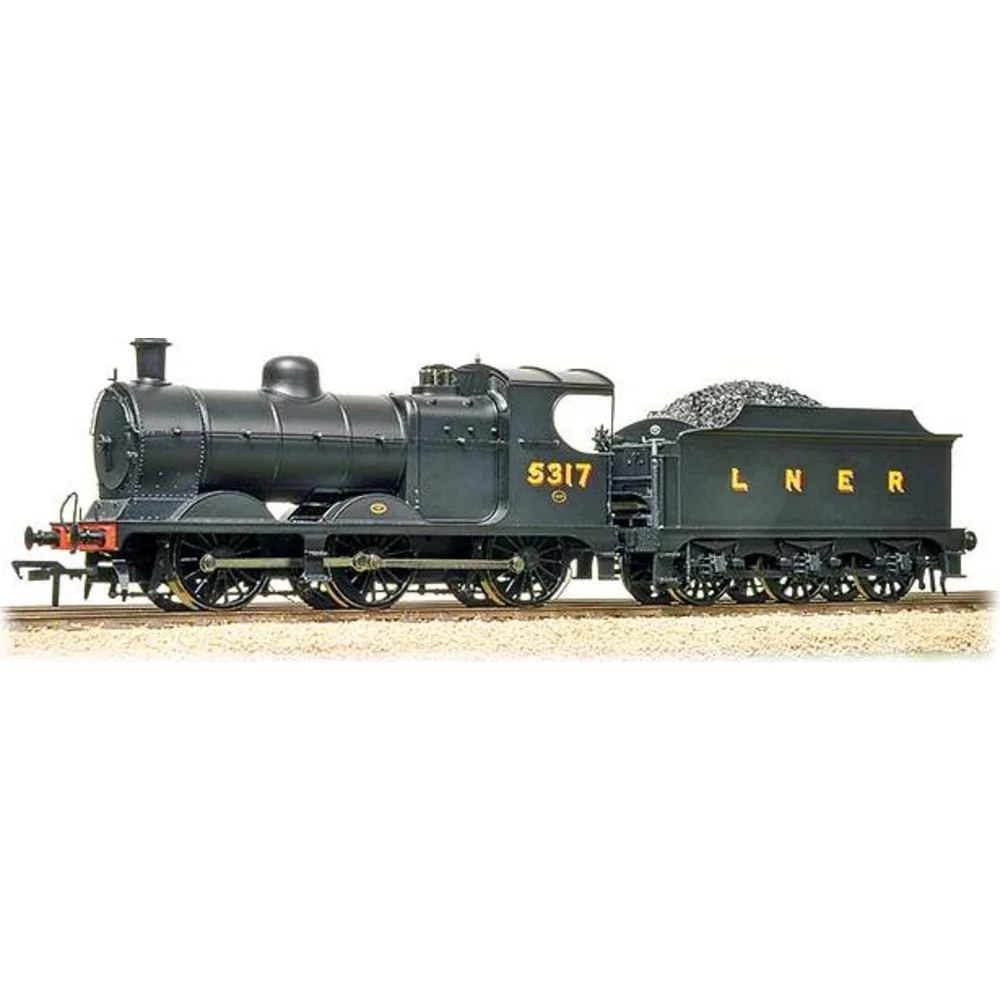Bachmann 31-318
London & North Eastern Railway J11 5317 London & North Eastern Railway Black
Tooling
Announced in 2013, Bachmann Branchline introduced an all-new OO gauge tooling for the Robinson-designed Great Central Railway Class 9J, later classified by the LNER as Class J11. These 0-6-0 freight locomotives, nicknamed “Pom-Poms,” were built between 1901 and 1910 and served extensively under the GCR, LNER, and British Railways until the early 1960s. The model filled a significant gap for pre-grouping and early LNER enthusiasts, offering a highly detailed representation of this iconic goods engine.
Tooling Features
- Scale: OO gauge (1:76).
- Construction: Precision-moulded plastic bodyshell with mixed metal/plastic chassis for strength and weight.
- Detailing: Factory-fitted separate details including handrails, lamp irons, pipework, reverser, safety valves, smokebox door dart, whistle, sprung buffers, and detailed cab interior with glazing. A fallplate between loco and tender is included.
- Tender: Permanently coupled to the locomotive, housing the PCB and provision for a speaker.
- Couplings: NEM pockets with tension-lock couplers.
Mechanical & Electrical
- Motor: Smooth-running 3-pole motor located in the locomotive.
- Drive: Loco-driven wheels with pickups on 5 of 6 axles.
- Minimum Radius: Second radius curves (approx. 438mm).
- Weighting: Metal components within boiler and chassis for improved adhesion.
- Lighting: No factory lighting fitted.
- Power Collection: 2-rail DC.
DCC Capability
- DCC Ready with a 21-pin socket located in the tender.
- Provision for a speaker for sound installation.
- Factory-fitted DCC and sound versions were also offered in later releases.
Liveries Produced
- Great Central Railway black (Collectors Club limited edition).
- LNER black (1923–1947).
- BR plain black (1948 onwards).
- BR black with early emblem.
- BR black with late crest.
Reviews & Commentary
Model railway reviewers and enthusiasts praised the J11 tooling for its fine detailing, accurate proportions, and smooth running. Video reviews highlight the model’s robust mechanism and authentic appearance, though some noted the permanently coupled tender and absence of factory lighting as minor drawbacks. Social media discussions generally regard the J11 as one of Bachmann’s best pre-grouping releases, with positive feedback on its versatility for freight and mixed-traffic layouts.
Interesting Notes
- The prototype locomotives were known as “Pom-Poms” due to their exhaust sound resembling a quick-firing gun.
- Special editions included weathered and sound-fitted versions for collectors.
Class & Prototype
- Class: London & North Eastern Railway J11
- Traction: Steam
- Built: 1901-1910
- Total Built: 174
- Running Number: 5317
The GCR Class 9J was John G. Robinson's first complete goods locomotive design, with 174 examples built 1901-1910 by five manufacturers. These versatile 0-6-0s hauled coal traffic, mixed goods, and passenger services across six decades, pioneering the Robinson superheater that became LNER Group Standard. Nicknamed "Pom-Poms" for their distinctive exhaust beat, they served the GCR, LNER, and BR until 1962. Despite remarkable longevity, not one survived preservation. Bachmann's OO gauge range (2013-present) provides authentic LNER and BR variants with optional DCC sound capturing the characteristic rapid exhaust.
Operator & Livery
- Operator: London & North Eastern Railway
- Livery: Black
- Era: 3 - The big 4 – LMS, GWR, LNER & SR
The London & North Eastern Railway emerged in 1923 as Britain's second-largest railway company, combining seven major railways including the Great Northern, North Eastern, and Great Eastern into a 6,590-mile network stretching from London's four terminals to the Scottish Highlands. Despite serving economically challenged industrial regions, the LNER achieved worldwide recognition for engineering excellence and speed records that remain unbroken today.
Under Chief Mechanical Engineers Sir Nigel Gresley, Edward Thompson, and Arthur Peppercorn, the LNER developed revolutionary locomotive designs characterised by three-cylinder layouts and streamlined aesthetics. Gresley's masterpieces included the A1 Pacifics featuring Flying Scotsman and the legendary A4 class, culminating in Mallard's world steam speed record of 126 mph in 1938.
The company pioneered luxury express services including the Silver Jubilee and Coronation streamliners, whilst investing in forward-thinking electrification schemes and massive marshalling yards. Notable achievements included operating the complete East Coast Main Line, introducing Britain's first regular 400-mile non-stop service, and commissioning Eric Gill's iconic typography that influenced railway design for decades.
Nationalised in 1948, LNER locomotives continued serving British Railways until the 1960s, with some A4 Pacifics working Scottish expresses until 1966. Today, the LNER's engineering legacy thrives through extensive preservation, new-build projects like Tornado, and comprehensive model ranges covering every major class in all popular scales, making LNER subjects essential for discerning railway modellers seeking authentic British steam-age atmosphere.
The LNER plain black livery emerged as a practical economy measure that ultimately became the most widely applied colour scheme in the company's history. Initially introduced for goods engines in 1928 to reduce painting costs and labour time, this austere unlined black finish dispensed with decorative red lining whilst retaining the basic yellow lettering and "L N E R" tender markings. The livery reflected the harsh economic realities facing the LNER, particularly as the company served Britain's struggling industrial regions during the depression years of the 1930s.
The plain black scheme reached its zenith during World War II when, from 1941 onwards, austerity measures mandated that all locomotive classes receive unlined black paint regardless of their previous prestigious liveries. The transformation was dramatic – even the magnificent streamlined A4 Pacifics like Mallard and Flying Scotsman were painted in stark black, their elegant engineering unchanged but their glamorous appearance replaced by wartime utility. The austerity deepened in October 1943 when tender lettering was reduced from "L N E R" to simply "N E", halving material usage and painting time whilst creating one of the most recognisable images of Britain's wartime railways. For modellers, this livery authentically represents the challenging economic and wartime periods, offering dramatic visual impact and historical accuracy when depicting late 1920s freight operations, 1930s depression-era scenes, or the austere years of 1941-1947 when Britain's railways prioritised function over form.
